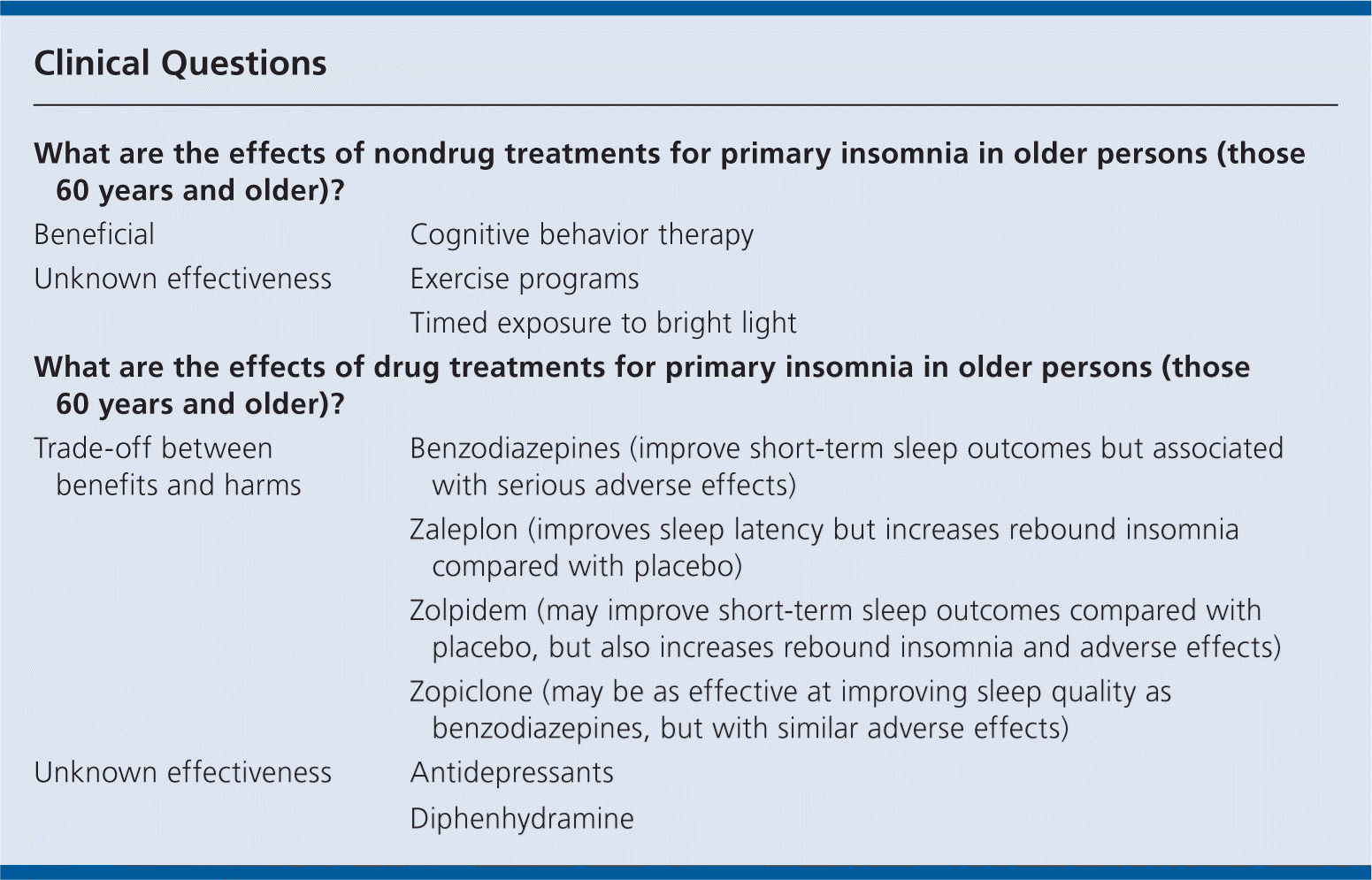
Am Fam Physician. 2013;87(4):280-281
Author disclosure: Cathy Alessi has received research funding from Sepracor, Inc., the Veterans Administration, and the National Institutes of Health within the past five years. She has also been a consultant for Prescription Solutions, Inc. within this time. Michael V. Vitiello has served as a speaker and consultant for Takeda Pharmaceuticals and as a consultant for Sanofi-Aventis.
Up to 40 percent of older adults have insomnia, with difficulty falling asleep, early awakening, or feeling tired on awakening.
The prevalence of insomnia increases with age. Other risk factors include medical and psychiatric illnesses, psychological factors, stress, daytime napping, and hyperarousal.
Primary insomnia is a chronic and relapsing condition that may increase the risk of accidents.
Primary insomnia is chronic insomnia without specific underlying medical, psychiatric, or other sleep disorders. This review covers only primary insomnia in persons 60 years and older.
Cognitive behavior therapy improves sleep compared with no treatment. Exercise may improve sleep symptoms compared with no treatment, but evidence is weak. We do not know whether timed exposure to bright light can improve sleep quality compared with no treatment.
Zaleplon, zolpidem, and zopiclone may improve sleep latency in older persons, although long-term effects are unknown, and they may cause adverse effects.
Zolpidem and zopiclone may also increase sleep duration and improve sleep quality in the short term compared with placebo.
Zaleplon has not been shown to decrease the number of awakenings, and it may cause rebound insomnia after discontinuation of treatment.
Benzodiazepines may improve sleep outcomes compared with placebo or other treatments, but they may cause adverse effects.
We do not know the long-term effects of benzodiazepines.
Benzodiazepines can cause impairment of memory, cognitive function, and psychological function, and rebound insomnia. They may increase the risks of accidents, falls, and hip fractures in older persons.
We do not know whether diphenhydramine improves sleep quality in older persons.
We do not know whether antidepressants improve sleep outcomes in older persons with primary insomnia, because we found no randomized controlled trials.

| What are the effects of nondrug treatments for primary insomnia in older persons (those 60 years and older)? | |
| Beneficial | Cognitive behavior therapy |
| Unknown effectiveness | Exercise programs |
| Timed exposure to bright light | |
| What are the effects of drug treatments for primary insomnia in older persons (those 60 years and older)? | |
| Trade-off between benefits and harms | Benzodiazepines (improve short-term sleep outcomes but associated with serious adverse effects) |
| Zaleplon (improves sleep latency but increases rebound insomnia compared with placebo) | |
| Zolpidem (may improve short-term sleep outcomes compared with placebo, but also increases rebound insomnia and adverse effects) | |
| Zopiclone (may be as effective at improving sleep quality as benzodiazepines, but with similar adverse effects) | |
| Unknown effectiveness | Antidepressants |
| Diphenhydramine | |
Definition
Insomnia is defined by the International Classification of Sleep Disorders, 2nd ed., as repeated difficulty with sleep initiation, duration, consolidation, or quality that occurs despite adequate time and opportunity for sleep, and results in some form of daytime impairment. Chronic insomnia is defined as insomnia occurring at least three nights a week for one month or longer. Primary insomnia is defined as chronic insomnia without specific underlying medical, psychiatric, or other sleep disorders, such as sleep apnea, depression, dementia, periodic limb movement disorder, or circadian rhythm sleep disorder. This review covers only primary insomnia in older persons. For this review, we define older persons as those 60 years and older.
Incidence and Prevalence
One population survey in Sweden found that, across all adult age groups, up to 40 percent of individuals had insomnia. A U.S. survey of persons 18 to 79 years of age found that insomnia affected 35 percent of all adults during the course of one year, and that prevalence increased with age, with estimates ranging from 31 to 38 percent in persons 18 to 64 years of age, to 45 percent in persons 65 to 79 years of age. One U.S. prospective cohort study found that between 23 and 34 percent of persons older than 65 years had insomnia, and between 7 and 15 percent had chronic insomnia. The study also reported a higher incidence of insomnia in women than in men.
Etiology and Risk Factors
The cause of insomnia is uncertain. The risk of primary insomnia increases with age and may be related to changes in circadian rhythms associated with age, or the onset of chronic conditions and poorer health as a result of aging. Psychological factors and lifestyle changes may exacerbate perceived effects of changes in sleep patterns associated with age, leading to reduced satisfaction with sleep. Other possible risk factors in all age groups include hyperarousal, chronic stress, and daytime napping.
Prognosis
We found few reliable data on long-term morbidity and mortality in persons with primary insomnia. Primary insomnia is a chronic and relapsing condition. Likely consequences include reduced quality of life and increased risk of accidents owing to daytime sleepiness. Persons with primary insomnia may be at greater risk of dependence on hypnotic medications, depression, dementia, and falls, and may be more likely to require residential care.
EDITOR'S NOTE: Zopiclone is not available in the United States.
SEARCH DATE: December 2010.
Adapted with permission from Alessi C, Vitiello MV. Insomnia (primary) in older people. Clin Evid Handbook.
